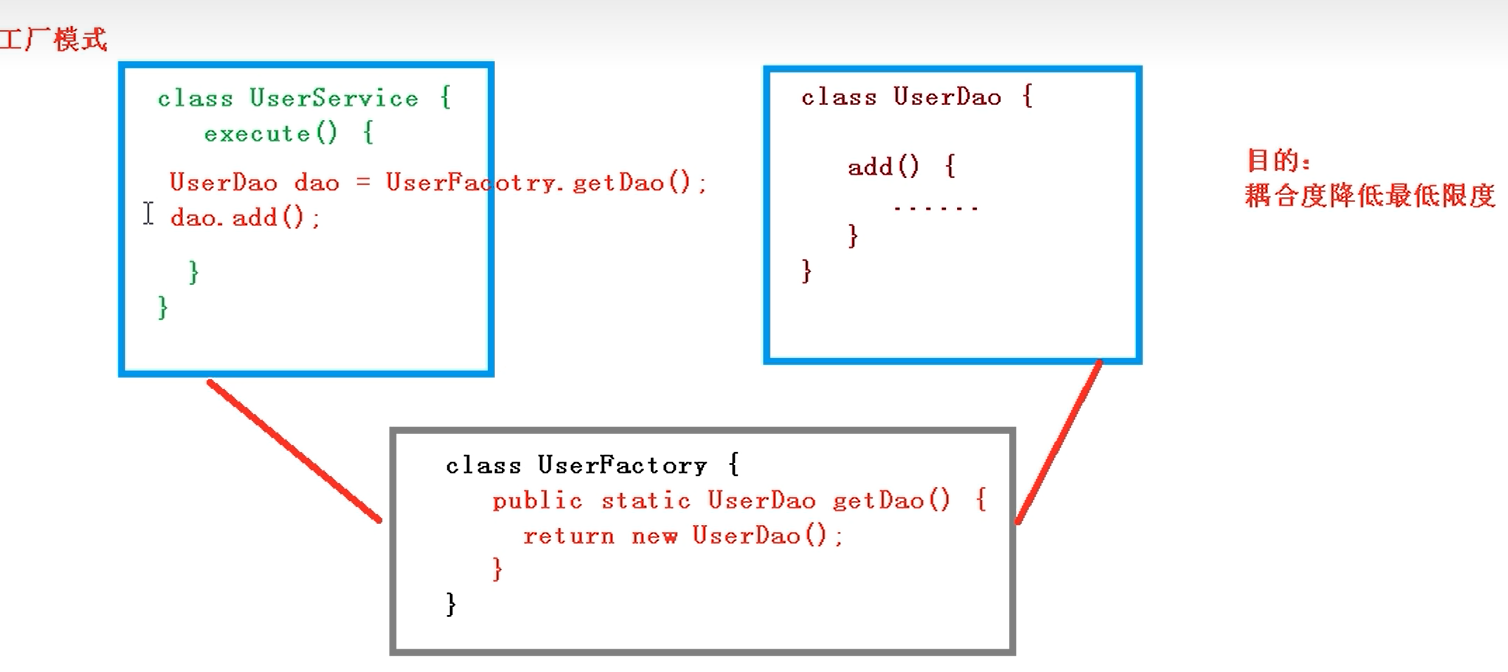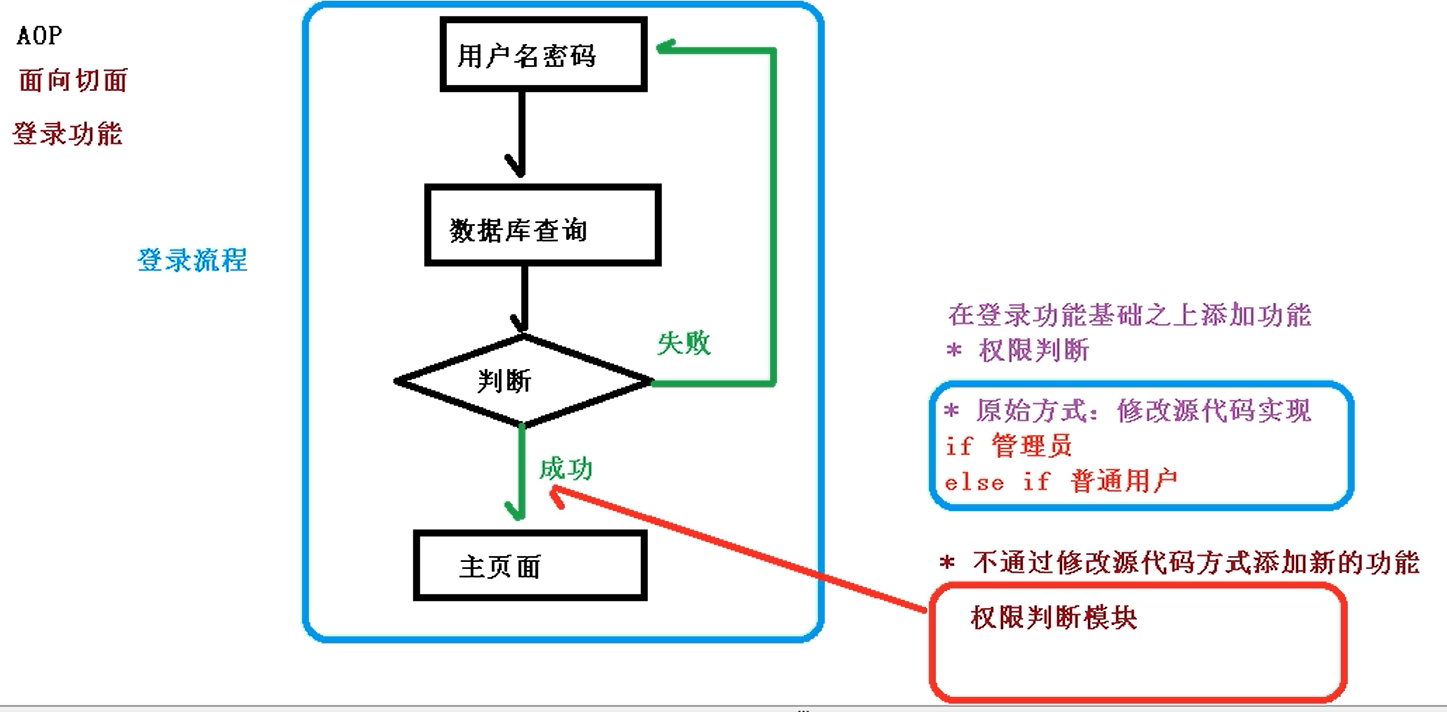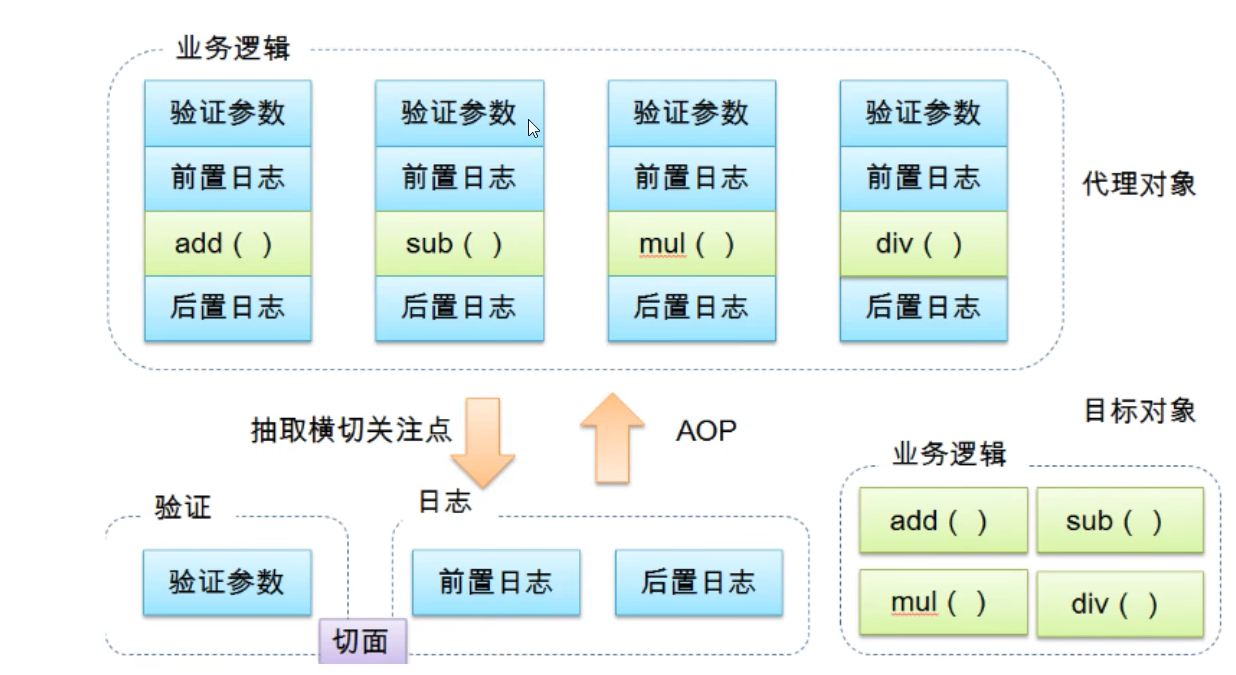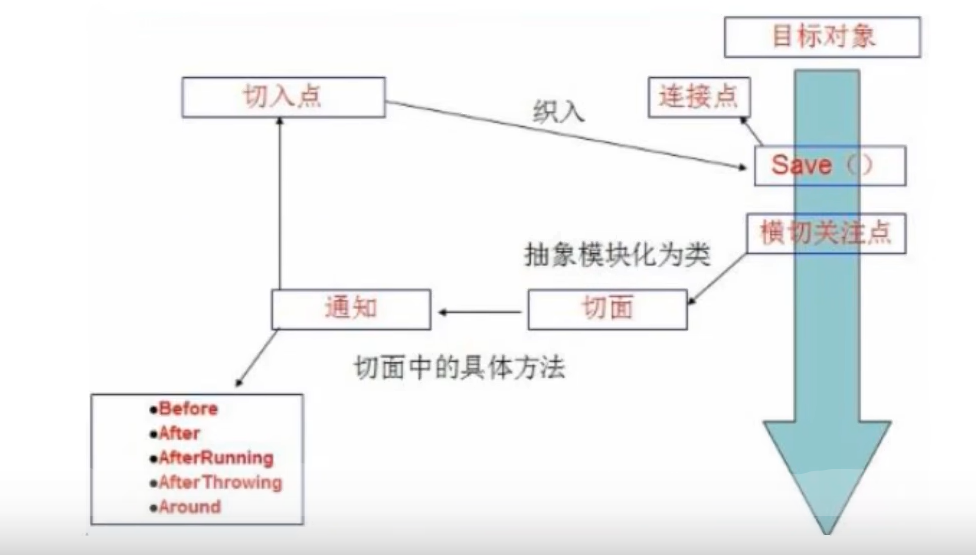Spring
Spring官方文档请点我
Spring 是轻量级的开源的 JavaEE 框架,用于解决企业应用开发的复杂性,其核心为 IOC 和 AOP
- Spring 是开源的、轻量级免费框架
- 控制反转(IOC)和面向切面编程(AOP)
- IOC 控制反转:把创建对象过程交给 Spring 管理
- AOP 面向切面:不修改源代码进行功能增强
- 支持事务处理,对框架整合的支持
Spring 特点
- 方便解耦,简化开发
- AOP 编程支持
- 方便程序的测试
- 方便和其他框架整合
- 方便进行事务操作
- 降低API开发难度
Spring三核心
- 控制反转 IOC
- 依赖注入 DI
- 面向切面编程 AOP
IOC
基本概念
IOC 概念
- 控制反转,把 对象创建和对象之间的调用过程,交给 Spring 管理
- 目的:降低耦合度
底层原理
原始方式

工厂模式

IOC 过程

IOC 思想基于 IOC 容器完成,IOC 容器底层是对象工厂
Spring 提供 IOC 容器实现两种方式:(两个接口)
- BeanFactory :IOC 容器基本实现,是 Spring 内部的使用接口
- ApplicationContext :BeanFactory 的子接口,提供更强大的功能
IOC 操作
Bean 管理
Bean 管理操作
Bean 管理方式
基于配置
创建对象
1
| <bean id="user" class="com.cyan.User"></bean>
|
在 Spring 配置文件中,使用 bean 标签,添加对应属性,即可创建对象
常见属性
创建对象时,默认使用无参构造方法完成对象创建
如果要使用有参构造有三种方式
下标赋值
1
2
3
4
|
<bean id="userIndex" class="com.cyan.pojo.User">
<constructor-arg index="0" value="index"/>
</bean>
|
参数类型
1
2
3
4
|
<bean id="userType" class="com.cyan.pojo.User">
<constructor-arg type="java.lang.String" value="Type"/>
</bean>
|
参数名
1
2
3
4
|
<bean id="userName" class="com.cyan.pojo.User">
<constructor-arg name="name" value="name"/>
</bean>
|
注入属性
DI:依赖注入,即注入属性
set方法
1
2
3
| <bean id="address" class="com.cyan.pojo.Address">
<property name="address" value="南通"/>
</bean>
|
有参构造方法
创建类,定义属性,创建属性对应的构造方法,然后在Spring配置文件中配置
1
2
3
4
5
6
7
8
9
| public class Orders {
private String oname;
private String address;
public Orders(String oname, String address) {
this.oname = oname;
this.address = address;
}
}
|
1
2
3
4
| <bean id="oders" class="com.cyan.pojo.Oders">
<constructor-arg name="oname" value="电脑"></constructor-arg>
<constructor-arg name="address" value="China"></constructor-arg>
</bean>
|
基于注解
注解概念
- 注解:代码特殊标记,格式,@注解名称(属性名称=属性值,…)
- 使用注解,注解可以作用在类上面,方法上面,属性上面
- 使用目的:简化 xml 配置
创建对象
引入 spring-aop 依赖并且开启组件扫描
1
2
3
4
5
|
<context:component-scan base-package="com.cyan"></context:component-scan>
|
example 1
1
2
3
4
5
6
7
8
|
<context:component-scan base-package="com.cyan" use-default-fliters="false">
<context:include-filter type="annotation"
expression="org.springframework.stereotype.Controller"/>
</context:component-scan>
|
example 2
1
2
3
4
5
6
7
8
|
<context:component-scan base-package="com.cyan">
<context:exclude-filter type="annotation"
expression="org.springframework.stereotype.Controller"/>
</context:component-scan>
|
注入属性
| 注解 |
说明 |
@Autowired |
根据属性类型进行自动装配 |
@Qualifier |
根据属性名称进行注入[@Autowired和@Qualifier一起使用] |
@Resource |
可以根据类型注入,可以根据名称注入 |
@Value |
注入普通类型属性 |
@Resource 和 @Autowired 区别
- 都用来自动装配,放在属性字段上
- @Autowired 通过 byType 实现,要求对象存在
- @Resource 通过 byName 实现,若找不到名字,通过 byType 实现
@Autowired
1
2
3
4
5
6
7
8
9
10
11
| @Service
public class UserService {
@Autowired
private UserDao userDao;
}
@Repository
public class UserDaoImpl implements UserDao{
}
|
@Qualifier
1
2
3
4
5
6
7
8
9
10
11
12
| @Service
public class UserService {
@Autowired
@Qualifier(value="userDaoImpl")
private UserDao userDao;
}
@Repository(value="userDaoImpl")
public class UserDaoImpl implements UserDao{
}
|
@Resource
1
2
3
4
5
6
7
8
9
10
11
|
@Service
public class UserService {
@Resource
private UserDao userDao;
}
@Repository(value="userDaoImpl")
public class UserDaoImpl implements UserDao{
}
|
1
2
3
4
5
6
7
8
9
10
11
|
@Service
public class UserService {
@Resource(value="userDaoImpl")
private UserDao userDao;
}
@Repository(value="userDaoImpl")
public class UserDaoImpl implements UserDao{
}
|
@Value
1
2
| @Value(value="var")
private String name;
|
c 命名空间注入
1
2
3
4
5
6
7
8
9
10
11
| <?xml version="1.0" encoding="UTF-8"?>
<beans xmlns="http://www.springframework.org/schema/beans"
xmlns:xsi="http://www.w3.org/2001/XMLSchema-instance"
xmlns:p="http://www.springframework.org/schema/p"
xmlns:c="http://www.springframework.org/schema/c"
xsi:schemaLocation="http://www.springframework.org/schema/beans
https://www.springframework.org/schema/beans/spring-beans.xsd">
<bean id="user2" class="com.cyan.pojo.User" c:age="18" c:name="CName"/>
</beans>
|
p 命名空间注入
1
2
3
4
5
6
7
8
9
10
11
| <?xml version="1.0" encoding="UTF-8"?>
<beans xmlns="http://www.springframework.org/schema/beans"
xmlns:xsi="http://www.w3.org/2001/XMLSchema-instance"
xmlns:p="http://www.springframework.org/schema/p"
xmlns:c="http://www.springframework.org/schema/c"
xsi:schemaLocation="http://www.springframework.org/schema/beans
https://www.springframework.org/schema/beans/spring-beans.xsd">
<bean id="user" class="com.cyan.pojo.User" p:name="PName" p:age="18"/>
</beans>
|
注入外部 Bean
1
2
3
4
5
6
7
8
9
10
| public class UserService {
private UserDao userDao;
public void setUserDao(UserDao userDao) {
this.userDao = userDao;
}
public void add() {
...
}
}
|
1
2
3
4
5
6
7
8
9
10
|
<bean id="userService" class="com.cyan.service.UserService">
<property name="userDao" ref="userDaoImpl">
</bean>
<bean id="userDaoImpl" class="com.cyan.dao.UserDaoImpl"></bean>
|
注入内部 Bean 和级联赋值
1
2
3
4
5
6
7
8
9
10
11
12
13
14
15
16
17
18
19
20
21
22
23
24
25
| public class Dept {
private String dname;
public void setDname(String dname) {
this.dname = dname;
}
}
public class Emp {
private String ename;
private String gender;
private Dept dept;
public void setEname(String ename) {
this.ename = ename;
}
public void setGender(String gender) {
this.gender = gender;
}
public void setDept(Dept dept) {
this.dept = dept;
}
}
|
注入内部 Bean
1
2
3
4
5
6
7
8
9
10
11
12
|
<bean id="emp" class="com.cyan.bean.Emp">
<property name="ename" value="cyan"></property>
<property name="gender" value="男"></property>
<property name="dept">
<bean id="dept" class="com.cyan.bean.Dept">
<property name="dname" value="销售部"></property>
</bean>
</property>
</bean>
|
级联赋值
1
2
3
4
5
6
7
8
9
10
11
|
<bean id="emp" class="com.cyan.bean.Emp">
<property name="ename" value="cyan"></property>
<property name="gender" value="男"></property>
<property name="dept" ref="dept"></property>
</bean>
<bean id="dept" class="com.cyan.bean.Dept">
<property name="dname" value="销售部"></property>
</bean>
|
注入集合属性
1
2
3
4
5
6
7
8
9
10
11
12
13
14
15
16
17
18
19
| public class Student {
private String[] courses;
private List<String> lists;
private Map<String, String> maps;
private Set<String> sets;
private List<Course> courseList;
...
}
|
数组类型属性注入
1
2
3
4
5
6
7
8
9
10
|
<bean id="student" class="com.cyan.pojo.Student">
<property name="courses">
<array>
<value>Java</value>
<value>Spring</value>
</array>
</property>
</bean>
|
list 类型属性注入
1
2
3
4
5
6
7
8
9
10
|
<bean id="student" class="com.cyan.pojo.Student">
<property name="lists">
<list>
<value>Spring MVC</value>
<value>SpringBoot</value>
</list>
</property>
</bean>
|
map 类型属性注入
1
2
3
4
5
6
7
8
9
10
|
<bean id="student" class="com.cyan.pojo.Student">
<property name="maps">
<map>
<entry key="JAVA" value="java"></entry>
<entry key="SPRING" value="spring"></entry>
</map>
</property>
</bean>
|
set 类型属性注入
1
2
3
4
5
6
7
8
9
10
|
<bean id="student" class="com.cyan.pojo.Student">
<property name="sets">
<set>
<value>MySQL</value>
<value>Redis</value>
</set>
</property>
</bean>
|
list 对象集合类型属性注入
1
2
3
4
5
6
7
8
9
10
11
12
13
14
15
16
17
18
19
|
<bean id="student" class="com.cyan.pojo.Student">
<property name="courseList">
<list>
<ref bean="course1"></ref>
<ref bean="course2"></ref>
</list>
</property>
</bean>
<bean id="course1" class="com.cyan.pojo.Course">
<property name="cname" value="Spring 5 Framework"></property>
</bean>
<bean id="course2" class="com.cyan.pojo.Course">
<property name="cname" value="Mybatis Framework"></property>
</bean>
|
提取集合注入部分
Spring 配置文件引入命名空间 util
1
2
3
| xmlns:c="http://www.springframework.org/schema/util"
xsi:schemaLocation="http://www.springframework.org/schema/util
https://www.springframework.org/schema/util/spring-util.xsd"
|
使用 util 标签完成 list 集合注入
1
2
3
4
5
6
7
8
9
10
|
<util:list id="bookList">
<value>var1</value>
<value>var2</value>
</util:list>
<bean id="book" class="com.cyan.pojo.Book">
<property name="list" ref="bookList"></property>
</bean>
|
注入总结
普通值注入
1
2
|
<property name="name" value="Cyan"/>
|
注入 ref
1
2
|
<property name="address" ref="address"/>
|
Array 注入
1
2
3
4
5
6
7
8
|
<property name="books">
<array>
<value>JAVA</value>
<value>C++</value>
<value>Python</value>
</array>
</property>
|
List 注入
1
2
3
4
5
6
7
8
|
<property name="hobbies">
<list>
<value>SING</value>
<value>CODE</value>
<value>SLEEP</value>
</list>
</property>
|
Map 注入
1
2
3
4
5
6
|
<property name="card">
<map>
<entry key="Card" value="14725869"/>
</map>
</property>
|
Set 注入
1
2
3
4
5
6
|
<property name="games">
<set>
<value>LOL</value>
</set>
</property>
|
NULL 注入
1
2
3
4
|
<property name="wife">
<null/>
</property>
|
Properties 注入
1
2
3
4
5
6
|
<property name="info">
<props>
<prop key="Sno">123456</prop>
</props>
</property>
|
属性值包含特殊符号
1
2
3
4
|
<property name="address">
<value>![CDATA[《南京》]]</value>
</property>
|
Bean 类型
Spring 有两种类型 bean,一种普通 bean,另一种 FactoryBean
普通 bean
在配置文件中定义 bean 类型就是 返回类型
FactoryBean
在配置文件定义 bea n类型 可以和返回类型不一样
创建类,让该类作为工厂 bean,实现接口 FactoryBean
实现接口的方法,在实现的方法中 定义返回的 bean 类型
1
2
3
4
5
6
7
8
9
10
11
12
13
14
15
16
17
18
19
20
21
22
|
public class MyBean implements FactoryBean {
public Object getObject() throws Exception {
Course course = new Course();
course.setCname("Java");
return course;
}
public Class<?> getObjectType() {
}
public boolean isSingleton() {
}
}
public void test() {
ApplicationContext context = new ClassPathXmlApplicationContext("application-context.xml");
Course course = context.getBean("myBean", Course.class);
System.out.println(course);
}
|
1
2
| <bean id="myBean" class="com.cyan.factorybean.MyBean">
</bean>
|
Bean 作用域
在 Spring 里面,默认情况下,bean 是单实例
如何设置创建的 Bean 属于单实例还是多实例
在 spring 配置文件 bean 标签里面有 属性scope [scope用于设置单实例还是多实例]
singleton,表示单实例对象,默认值prototype,表示多实例对象
singleton 和 prototype 区别
- scope 域中设置 singleton 表示单实例,设置 prototype 表示多实例
- scope 域中设置值是 singleton,加载 spring 配置文件时 就会 创建单实例对象
- scope 域中设置值是 prototype,不是在加载 spring 配置文件时创建对象,而是在调用 getBean 方法时 创建多实例对象
Bean 生命周期
生命周期
生命周期表示从对象创建到对象销毁的过程。
bean 生命周期
- 通过构造器创建 bean 实例(无参数构造)
- 为 bean 的属性设置值和对其他 bean 引用(调用set方法)
- (把 bean 实例传递 bean 后置处理器的方法[postProcessBeforeInitialization])
- 调用 bean 的初始化方法(需要进行配置)
- (把 bean 实例传递 bean 后置处理器的方法[postProcessAfterInitialization])
- bean 可以使用了(对象获取到了)
- 当容器关闭时,调用 bean 的销毁方法(需要进行配置 )
Bean 自动装配
自动装配
根据指定装配规则(属性名称或属性类型),Spring 自动 将匹配的 属性值注入
- 自动装配是 Spring 满足 bean 依赖的一种方式
- Spring 会在上下文自动寻找,并自动给 bean 装配属性
装配方式
xml 配置
java 配置
隐式自动装配 bean
1
2
3
4
5
| <bean id="cat" class="com.cyan.pojo.Cat"/>
<bean id="dog" class="com.cyan.pojo.Dog"/>
<bean id="person" class="com.cyan.pojo.Person" autowire="byName">
<property name="name" value="Name"/>
</bean>
|
byName[属性名称]
byType[属性类型]
注解实现自动装配
1.导入命名空间 context
2.开启注解支持
如果@Autowired自动装配,无法通过一个注解完成,可以使用@Qualifier(value=””)配合使用
引入外部属性文件
直接配置数据库信息
1
2
3
4
5
6
| <bean id="dataSource" class="com.alibaba.druid.pool.DriudDataSource">
<property name="driverClassName" value="com.mysql.jdbc.Driver"></property>
<property name="url" value="jdbc://localhost:3306/user_db"></property>
<property name="username" value="****"></property>
<property name="password" value="****"></property>
</bean>
|
引入外部属性文件配置数据库
- 编写 properties 文件
- 将 properties 文件引入 spring 配置文件,同时引用
context 命名空间
1
2
3
4
| driverClass=com.mysql.jdbc.Driver
url=jdbc://localhost:3306/user_db
username=xxxx
password=xxxx
|
1
2
3
4
5
6
7
8
9
|
<context:property-placeholder location="classpath:jdbc.properties"/>
<bean id="dataSource" class="com.alibaba.druid.pool.DriudDataSource">
<property name="driverClassName" value="${driverClass}"></property>
<property name="url" value="${url}"></property>
<property name="username" value="${username}"></property>
<property name="password" value="${password}"></property>
</bean>
|
AOP
基本概念
AOP 是面向切面编程,利用 AOP 可以对业务逻辑的各个部分进行隔离,从而使得业务逻辑各部分之间的耦合度降低,提高程序的可重用性,同时提高了开发效率。通俗来讲:不通过修改源代码方式,在主干功能里面添加新功能。

底层原理
AOP 底层使用 动态代理
动态代理使用情况
有接口情况,默认使用 JDK 动态代理
【创建接口实现类代理对象,增强类的方法】

没有接口情况,使用 CDLIB 动态代理
【创建子类的代理对象,增强类的方法】

AOP (JDK动态代理)
| 参数 |
说明 |
ClassLoader loader |
类加载器 |
类<?>[] interfaces |
增加方法所在的类,这类实现的接口,支持多个接口 |
InvocationHandler h |
实现该接口InvocationHandler,创建代理对象,写增强的方法 |
| 方法 |
说明 |
// java.lang.reflect.Proxy
static Object newProxyInstance(ClassLoader loader, 类<?>[] interfaces, InvocationHandler h) |
返回指定接口的代理类的实例,该接口将方法调用分派给指定的调用处理程序。 |
案例
1
2
3
4
5
6
|
public interface UserDao {
public int add(int a,int b);
public String update(String id);
}
|
1
2
3
4
5
6
7
8
9
|
public class UserDaoImpl implements UserDao {
public int add(int a, int b) {
return a+b;
}
public String update(String id) {
return id;
}
}
|
1
2
3
4
5
6
7
8
9
10
11
12
13
14
15
16
17
18
19
20
21
22
23
24
25
26
27
|
public class JDKProxy {
public void test() {
Class[] interfaces = (UserDao.class);
UserDaoImpl userDao = new UserDaoImpl();
UserDao dao = (UserDao)Proxy.newProxyInstance(JDKProxy.class.getClassLoader, interfaces, new UserDaoProxy(userDao));
int result = dao.add(1,2);
System.out.println("result:"+result);
}
class UserDaoProxy implements InvocationHandler {
private Object obj;
public UserDaoProxy(Object obj) {
this.obj = obj;
}
public Object invoke(Object proxy, Method method, Object[] args) throws Throwable {
System.out.println("在方法前执行"+method.getName()+":传递的参数"+Arrays.toString(args));
Object res = method.invoke(obj,args);
System.out.println("在方法后执行"+obj);
return res;
}
}
}
|
相关术语
| 术语 |
说明 |
| 连接点 |
类里面被增强的方法 |
| 切入点 |
实际被真正增强的方法 |
| 通知 |
实际增强的逻辑部分 |
| 切面 |
动作,把通知应用到切入点过程 |


Spring AOP 中,通过 Advice 定义横切逻辑,Spring 中支持 5 种类型的Advice:
| 通知类型 |
连接点 |
实现接口 |
| 前置通知 |
方法前 |
org.springframework.aop.MethodBeforeAdvice |
| 后置通知 |
方法后 |
org.springframework.aop.AfterReturningAdvice |
| 环绕通知 |
方法前后 |
org.aopalliance.intercept.MethodInterceptor |
| 异常抛出通知 |
方法抛出异常 |
org.springframework.aop.ThrowsAdvice |
| 引介通知 |
类中增加新的方法属性 |
org.springframework.aop.IntroductionInterceptor |
即 Aop 在不改变原有代码的情况下,去增加新的功能
相关操作
Spring 框架一般是 基于AspectJ实现 AOP 操作,AspectJ 不是 Spring 组成部分,独立 AOP 框架
在项目工程引入 AOP 依赖
切入点表达式:切入点表达式作用:知道对哪个类里面的方法进行增强
语法结构:
1
2
3
4
5
6
7
8
| execution([权限修饰符][返回类型][类全路径][方法名称][参数列表])
1.对com.cyan.dao.BookDao类的add进行增强
execution(* com.cyan.dao.BookDao.add(..))
2.对com.cyan.dao.BookDao类的所有方法增强
execution(* com.cyan.dao.BookDao.*(..))
2.对com.cyan.dao包里所有类的所有方法增强
execution(* com.cyan.dao.*.*(..))
|
配置实现
创建代理类和被代理类
1
2
3
4
5
6
7
8
9
10
11
| public class Book {
public void buy() {
}
}
public class BookProxy {
public void before() {
System.out.println("Before");
}
}
|
在配置文件中创建两个类对象
1
2
3
|
<bean id="book" class="com.cyan.Book"></bean>
<bean id="bookProxy" class="com.cyan.BookProxy"></bean>
|
在配置文件中配置切入点
1
2
3
4
5
6
7
|
<aop:config>
<aop:pointcut id="p" expression="execution(* com.cyan.Book.buy(..))"/>
<aop:before method="before" pointcut-ref="p"/>
</aop:config>
|
注解实现
创建被代理类并定义方法
1
2
3
4
5
| public class User {
public void add() {
}
}
|
编写代理类[不同方法代表不同通知类型]
1
2
3
4
5
6
| public class UserProxy {
public void before() {
}
}
|
配置通知[注意:要引入aop命名空间]
开启注解扫描
1
2
|
<context:component-scan base-package="com.cyan"></context:component-scan>
|
创建User和UserProxy对象
1
2
3
4
5
| @Component
public class User {
@Component
public class UserProxy {
|
在代理类上面添加注解@Aspect
1
2
3
| @Component
@Aspect
public class UserProxy {
|
在配置文件中开启生成代理对象
1
2
|
<aop:aspectj-autoproxy></aop:aspectj-autoproxy>
|
配置不同类型通知
在代理类里面,在作为通知方法上面添加通知类型注解,使用切入点表达式
1
2
3
4
5
6
7
8
9
10
11
12
13
14
15
16
17
18
19
20
21
22
23
24
25
26
27
28
29
30
31
| @Component
@Aspect
public class UserProxy {
@Before(value="execution(* com.cyan.User.add(..))")
public void before() {
System.out.print("Before method")
}
@After(value="execution(* com.cyan.User.add(..))")
public void after() {
System.out.print("After method")
}
@AfterThrowing(value="execution(* com.cyan.User.add(..))")
public void afterThrowing() {
System.out.print("AfterThrowing method")
}
@Around(value="execution(* com.cyan.User.add(..))")
public void around(ProceedingJoinPoint pj) throws Throwable{
System.out.print("Before around method");
pj.proceed();
System.out.print("After around method");
}
@AfterReturning(value="execution(* com.cyan.User.add(..))")
public void afterReturning() {
System.out.print("AfterReturning method")
}
}
|
测试
1
2
3
4
5
| public void test() {
ApplicaiotnContext context = new ClassPathXmlApplicationContext("application-context.xml");
User user = context.getBean("user",User.class);
user.add();
}
|
完全注解开发
1
2
3
4
5
| @Configuration
@ComponentScan(basePackages={"com.cyan"})
@EnableAspectJAutoProxy(proxyTargetClass=true)
public class AopConfig {
}
|
注意事项
相同的切入点抽取
1
2
3
4
5
6
7
8
9
10
11
12
13
14
| @Component
@Aspect
public class UserProxy {
@Pointcut(value="execution(* com.cyan.User.add(..))")
public void pointcut() {
}
@Before(value="pointcut()")
public void before() {
System.out.print("Before method")
}
}
|
有多个增强类对同一个方法增强,优先级设置
在增强类上添加注解 @Order(数字类型值),数字类型值越小优先级越高
1
2
3
4
5
6
7
8
9
| @Component
@Aspect
@@Order(1)
public class UserProxy {
@Component
@Aspect
@@Order(2)
public class PersonProxy {
|
实战演练
引入依赖
1
2
3
4
5
6
| <dependency>
<groupId>org.aspectj</groupId>
<artifactId>aspectjweaver</artifactId>
<version>1.9.4</version>
<scope>runtime</scope>
</dependency>
|
使用 Spring 的API
BeforeLog
1
2
3
4
5
6
| public class BeforeLog implements MethodBeforeAdvice {
@Override
public void before(Method method, Object[] args, Object target) {
System.out.println(target.getClass().getName() + "'s " + method.getName() + "Invoked");
}
}
|
AfterLog
1
2
3
4
5
6
| public class AfterLog implements AfterReturningAdvice {
@Override
public void afterReturning(Object returnValue, Method method, Object[] args, Object target) {
System.out.println("Invoked " + method.getName() + "Return " + returnValue);
}
}
|
约束
1
2
3
4
5
6
7
8
9
10
| <?xml version="1.0" encoding="UTF-8"?>
<beans xmlns="http://www.springframework.org/schema/beans"
xmlns:xsi="http://www.w3.org/2001/XMLSchema-instance"
xmlns:aop="http://www.springframework.org/schema/aop"
xsi:schemaLocation="http://www.springframework.org/schema/beans
https://www.springframework.org/schema/beans/spring-beans.xsd
http://www.springframework.org/schema/aop
http://www.springframework.org/schema/aop/spring-aop-3.1.xsd">
</beans>
|
注册 bean
1
2
3
4
|
<bean id="userService" class="com.cyan.service.UserServiceImpl"/>
<bean id="beforeLog" class="com.cyan.log.BeforeLog"/>
<bean id="afterLog" class="com.cyan.log.AfterLog"/>
|
使用 Spring API
1
2
3
4
5
6
7
8
9
|
<aop:config>
<aop:pointcut id="pointcut" expression="execution(* com.cyan.service.UserServiceImpl.*(..))"/>
<aop:advisor advice-ref="beforeLog" pointcut-ref="pointcut"/>
<aop:advisor advice-ref="afterLog" pointcut-ref="pointcut"/>
</aop:config>
|
使用自定义 AOP[切面定义]
1
2
3
4
5
6
7
8
9
10
11
12
13
|
<bean id="appPointcut" class="com.cyan.aop.AppPointcut"/>
<aop:config>
<aop:aspect ref="appPointcut">
<aop:pointcut id="point" expression="execution(* com.cyan.service.UserServiceImpl.*(..))"/>
<aop:before method="before" pointcut-ref="point"/>
<aop:after method="after" pointcut-ref="point"/>
</aop:aspect>
</aop:config>
|
使用注解实现 AOP
1
2
3
4
5
6
7
8
9
10
11
12
13
14
15
16
17
18
19
20
21
22
23
| @Aspect
public class AnnotationPointcut {
@Before("execution(* com.cyan.service.UserServiceImpl.*(..))")
public void before() {
System.out.println("方法执行前");
}
@After("execution(* com.cyan.service.UserServiceImpl.*(..))")
public void after() {
System.out.println("方法执行后");
}
@Around("execution(* com.cyan.service.UserServiceImpl.*(..))")
public void around(ProceedingJoinPoint pj) throws Throwable {
System.out.println("环绕前");
Object proceed = pj.proceed();
System.out.println("环绕后");
}
}
|
事务
基本概念
事务
事务是数据库操作的 最小工作单元,是作为单个逻辑工作单元执行的一系列操作;这些操作作为一个整体一起向系统提交,要么都执行、要么都不执行;
ACID 特性
| 特性 |
说明 |
原子性(Atomicity) |
事务中所有操作是不可分割的原子单位。事务中所有操作要么全部执行成功,要么全部执行失败。 |
一致性(Consistency) |
事务执行后,数据库状态与其它业务规则保持一致。如转正业务,无论事务执行成功与否,参与转账的两个账号余额之和应该是不变的。 |
隔离性(Isolation) |
隔离性是指在并发操作中,不同事务之间应该隔离开来,使每个并发中的事务不会相互干扰。 |
持久性(Durability) |
一旦事务提交成功,事务中所有的数据操作都必须被持久化到数据库中,即使提交事务后,数据库马上崩溃,在数据库重启时,也必须你能保证通过某种机制恢复数据。 |
传播行为
事务的第一个方面是传播行为(propagation behavior)。当事务方法被另一个事务方法调用时,必须指定事务应该如何传播
| 传播属性 |
描述 |
REQUIRED |
如果有事务在运行,当前的方法就在这个事务内运行,否则,就启动一个新的事务,并在自己的事务内运行 |
REQUIRED_NEW |
当前的方法必须启动新事务,并在它自己的事务内运行,如果有事务正在运行,应该将它挂起 |
SUPPORTS |
如果有事务在运行,当前的方法就在这个事务内运行.否则它可以不运行在事务中 |
NOT_SUPPORTEI |
当前的方法不应该运行在事务中。如果有运行的事务,将它挂起 |
MANDATORY |
当前的方法必须运行在事务内部,如果没有正在运行的事务,就抛出异常 |
NEVER |
当前的方法不应该运行在事务中,如果有运行的事务,就抛出异常 |
NESTED |
如果有事务在运行,当前的方法就应该在这个事务的嵌套事务内运行。否则,就启动一个新的事务,并在它自己的事务内运行. |
隔离级别
隔离级别定义了一个事务可能受其他并发事务的程度。
脏读(Dirty reads)
脏读发生在一个事务读取了另一个事务 改写但尚未提交的数据 时。如果改写在稍后被回滚了,那么第一个事务获取的数据就是无效的。
不可重复读(Nonrepeatable read)
不可重复读发生在一个事务 执行相同的查询两次或两次以上,但是每次都得到不同的数据 时。这通常是因为 另一个并发事务在两次查询期间进行了更新。
幻读(Phantom read)
幻读与不可重复读类似。它发生在一个事务(T1)读取了几行数据,接着 另一个并发事务(T2)插入了一些数据时。在随后的查询中,第一个事务(T1)就会发现 多了一些原本不存在的记录。
不可重复读与幻读的区别
- 不可重复读的重点是 修改:同样的条件, 你读取过的数据, 再次读取出来发现值不一样了
- 幻读的重点在于 新增或者删除:同样的条件, 第1次和第2次读出来的 记录数不一样
- 对于前者, 只需要锁住 满足条件的记录。 对于后者, 要锁住 满足条件及其相近的记录。
| 隔离级别 |
含义 |
ISOLATION_DEFAULT |
使用后端数据库默认的隔离级别 |
ISOLATION_READ_UNCOMMITTED |
最低的隔离级别,允许读取尚未提交的数据变更,可能会导致脏读、幻读或不可重复读 |
ISOLATION_READ_COMMITTED |
允许读取并发事务已经提交的数据,可以阻止脏读,但是幻读或不可重复读仍有可能发生 |
ISOLATION_REPEATABLE_READ |
对同一字段的多次读取结果都是一致的,除非数据是被本身事务自己所修改,可以阻止脏读和不可重复读,但幻读仍有可能发生 |
ISOLATION_SERIALIZABLE |
最高的隔离级别,完全服从ACID的隔离级别,确保阻止脏读、不可重复读以及幻读,也是最慢的事务隔离级别,因为它通常是通过完全锁定事务相关的数据库表来实现的 |
|
脏读 |
不可重复读 |
幻读 |
READ UNCOMMITTED( 读未提交 ) |
有 |
有 |
有 |
READ COMMITTED( 读已提交 ) |
无 |
有 |
有 |
REPEATABLE READ(可重复读 ) |
无 |
无 |
有 |
SERIALIZABLE(串行化) |
无 |
无 |
无 |
声明式事务
在 Spring 进行事务操作
在 Spring 进行声明式事务管理,底层使用的是 AOP
基于注解
配置事务管理器
1
2
3
4
5
|
<bean id="transactionManager" class="org.springframework.jdbc.datasource.DataSourceTransactionManager">
<property name="dataSource" ref="dataSource"></property>
</bean>
|
开启事务注解
在 spring 配置文件中,引入tx命名空间
1
2
|
<tx:annotation-driven transaction-manager="transactionManager"></tx:annotation-driven>
|
Service 类上添加事务注解
1
2
3
| @Service
@Transactional
public class UserService{
|
完全注解开发:创建配置类代替配置文件
1
2
3
4
5
6
7
8
9
10
11
12
13
14
15
16
17
18
19
20
21
22
23
24
| @Configuration
@ComponentScan(basePackages={"com.cyan"})
@EnableTransactionManagement
public class TxConfig() {
@Bean
public DruidDataSource getDruidDataSource() {
DruidDataSource dataSource = new DruidDataSource();
dataSource.setDriverClassName("");
dataSource.setUrl("");
dataSource.setUsername("");
dataSource.setPassword("");
return dataSource;
}
@Bean
public JdbcTemplate getJdbcTemplate(DataSource dataSource) {
JdbcTemplate jdbcTemplate = new JdbcTemplat();
jdbcTemplate.setDataSource(dataSource);
return jdbcTemplate;
}
}
|
基于配置
配置事务管理器
1
2
3
4
5
|
<bean id="transactionManager" class="org.springframework.jdbc.datasource.DataSourceTransactionManager">
<property name="dataSource" ref="dataSource"></property>
</bean>
|
配置通知
1
2
3
4
5
6
7
8
|
<tx:advice id="txadvice">
<tx:attributes>
<tx:method name="account" propagation="REQUIRED"/>
</tx:attributes>
</tx:advice>
|
配置切入点和切面
1
2
3
4
5
6
7
|
<aop:config>
<aop:pointcut id="pt" expression="execution(* com.cyan.service.UserService.*(..))"/>
<aop:advisor advice-ref="txadvice" pointcut-ref="pt"/>
</aop:config>
|
参数配置
1
2
3
| @Service
@Transaction(popagation=Propagation.REQUIRED,isolation=Isolation.REPEATABLE_READ)
public void UserService{
|
| 参数 |
说明 |
| propagation |
事务传播行为 |
| isolation |
事务隔离级别 |
| timeout |
超时时间,事务需要在一定时间内提交,如果不提交进行回滚,默认值是-1,设置时间以秒单位进行计算 |
| readOnly |
是否只读(读:查询操作,写:增删改),readOnly默认值false,表示可以增删改查,设置readOnly值为true,只能查询 |
| rollbackFor |
回滚,设置出现哪些异常进行事务回滚 |
| noRollbackFor |
设置出现哪些异常不进行事务回滚 |

















